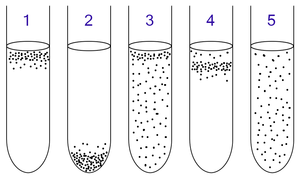Obligate aerobe
Appearance

1: Obligate aerobes need oxygen because they cannot ferment or respire anaerobically. They gather at the top of the tube where the oxygen concentration is highest.
2: Obligate anaerobes are poisoned by oxygen, so they gather at the bottom of the tube where the oxygen concentration is lowest.
3: Facultative anaerobes can grow with or without oxygen because they can metabolise energy aerobically or anaerobically. They gather mostly at the top because aerobic respiration generates more ATP than either fermentation or anaerobic respiration.
4: Microaerophiles need oxygen because they cannot ferment or respire anaerobically. However, they are poisoned by high concentrations of oxygen. They gather in the upper part of the test tube but not the very top.
5: Aerotolerant organisms do not require oxygen as they metabolise energy anaerobically. Unlike obligate anaerobes however, they are not poisoned by oxygen. They can be found evenly spread throughout the test tube.
An obligate aerobe is an organism that requires oxygen to grow.[1] Through cellular respiration, these organisms use oxygen to metabolise substances, like sugars or fats, to obtain energy. In this type of respiration, oxygen serves as the terminal electron acceptor for the electron transport chain.[1] Aerobic respiration has the advantage of yielding more energy (adenosine triphosphate or ATP) than fermentation or anaerobic respiration,[2] but obligate aerobes are subject to high levels of oxidative stress.[3]
Examples of obligately aerobic bacteria include Mycobacterium tuberculosis[4] and Nocardia asteroides.[5] With the exception of the yeasts, most fungi are obligate aerobes.[1] Also, almost all algae are obligate aerobes.[1]
See also
- Aerobic respiration
- Anaerobic respiration
- Fermentation
- Obligate anaerobe
- Facultative anaerobe
- Microaerophile
References
- ^ a b c d Prescott LM, Harley JP, Klein DA (1996). Microbiology (3rd ed.). Wm. C. Brown Publishers. pp. 130–131. ISBN 0-697-29390-4.
- ^ Hogg, S. (2005). Essential Microbiology (1st ed.). Wiley. pp. 99–100, 118–148. ISBN 0-471-49754-1.
- ^ "Obligate aerobe - definition from Biology-Online.org." Biology Online. Biology-Online, n.d. Web. 12 Dec 2009. <http://www.biology-online.org/dictionary/Obligate_aerobe>
- ^ Levinson, W. (2010). Review of Medical Microbiology and Immunology (11th ed.). McGraw-Hill. pp. 150–157. ISBN 978-0-07-174268-9.
- ^ Ryan KJ; Ray CG, eds. (2004). Sherris Medical Microbiology (4th ed.). McGraw Hill. pp. 460–462. ISBN 0-8385-8529-9.
